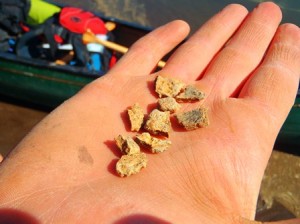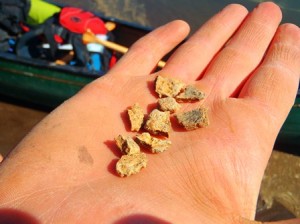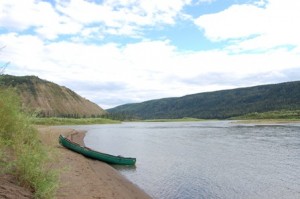
By Dr. Matthew Vavrek
During the summer of 2012, I spent five days floating down the Peace River with former Currie Museum palaeontologist Dr. Phil Bell and two graduate students from McGill University by the names of Trina Du and Ben Wilhelm. Although the Grande Prairie area is becoming well known for a whole host of dinosaurs and other extinct creatures, the animals that lived where the Peace River now flows were much older.
Near Grande Prairie, the exposed rocks are part of the Wapiti Formation, a unit of rocks that ranges from 80 to 69 million years old, while along the Peace River the exposed rocks are mostly from the Dunvegan Formation, and are about 94 million years old. In fact, the rocks along the Peace River contain some of the oldest dinosaurs from Alberta, and as such can help to fill in a number of holes in our understanding of dinosaur evolution in North America.
This past week, two scientific papers have been published that document the fossils that we found on our trip (Burns and Vavrek 2014; Vavrek et al. 2014). The first paper described several bones from an ankylosaur (armoured dinosaur). These bones were dermal ossicles, or bones that were embedded in the skin and that helped make up the bony armour of the dinosaur.

Ankylosaur ossicles. They may not look like much but those little pieces of bone hold many clues to the bones’ original owner.
Although they don’t look like much, we were able to slice open one of them and, by looking at the texture of the bone inside, we could tell that they were indeed from an ankylosaur. These were some of the first dinosaur bones described from the formation (there have been footprints published elsewhere).
The second paper that came out described a piece of a very large sturgeon, a group of fishes still found in rivers of Alberta, often harvested as a source of caviar. We only found a piece of the skull of this ancient sturgeon, but through comparisons to other more complete skeletons, we estimated the size of this fish to be around 5 metres long. As well, this is likely the oldest sturgeon known from North America, and possibly in the world, extending the record of these animals in Alberta by over 20 million years.
Although these two finds are interesting in their own right, they also show how important it is to keep exploring new areas for fossils. Although areas like those along the Peace River (and the Arctic even more so) do not often contain the most beautiful or complete fossils, discoveries in these areas are still very important in understanding why both ancient and modern ecosystems look the way they do.
References
Burns, M.E. and Vavrek, M.J. 2014. Probable Ankylosaur Ossicles from the Middle Cenomanian Dunvegan Formation of Northwestern Alberta, Canada. PLoS ONE 9:e96075. http://www.plosone.org/article/info%3Adoi%2F10.1371%2Fjournal.pone.0096075
Vavrek, M.J., Murray, A. and Bell, P.R. 2014. An early Late Cretaceous (Cenomanian) sturgeon (Acipenseriformes) from the Dunvegan Formation, northwestern Alberta, Canada. Canadian Journal of Earth Sciences, early online edition. http://www.nrcresearchpress.com/doi/abs/10.1139/cjes-2014-0052

